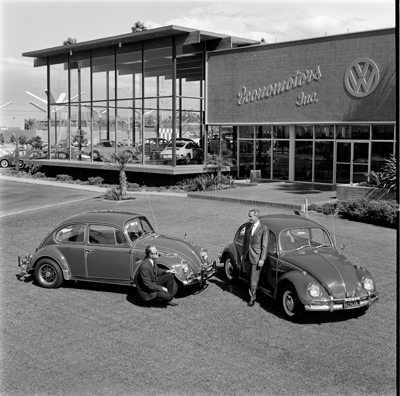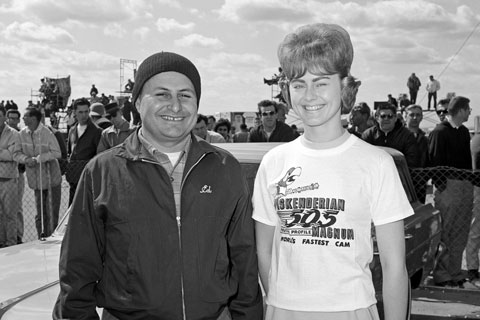SEMA News—July 2019
HERITAGE
By Drew Hardin
Small Wonder
Photos Courtesy Eric Rickman, Petersen Publishing Company Archive
 |
Hot Rod—the bible of all-American, big-cube performance—allotted four pages of its July 1967 issue to a story on an import-car dealership in Riverside, California, that was on the cutting edge of a growing automotive phenomenon.
For anyone wondering why Feature Editor Eric Dahlquist was filling valuable real estate with a story about funny-looking German cars, his story’s subhead laid the groundwork: “There are three million VWs in this country. The marque is sixth nationally in sales, and Beetle accessories are coming out our ears. Very few in the Detroit establishment understand why. They can’t figure out the kids either.”
Burn!
Detroit was in the thick of ramping up its musclecar offerings to capture the “youth market,” while, Dahlquist pointed out, “everywhere we look, in high-school parking lots, in college parking lots or just parking lot parking lots, a swarm of Beetles engulfs ever shrinking islands of ‘regular’ vehicles. Then there’s the VW hop-up phenomenon that is blazing out of sight in mushrooming potential, as more and more 1,700-lb. weaklings take the pay-as-you-go muscle-building treatment.”
Leading the way was Joe Vittone, his Economotors Porsche-VW dealership, and his line of VW aftermarket parts sold under the EMPI (European Motor Products Inc.) brand. That’s Vittone at right in the photo, leaning against a stock VW while Dahlquist kneels beside an “EMPI-ized” GTV Mk 4.
Of the dealership, Dahlquist said: “There’s enough shining glass, steel and landscaping here to vie with the GM Tech Center back in Warren, Michigan, and when you see the cushiony customer lounge and patio, conference rooms, combination parts counter and speed center, work area with waxed, rubber-tiled floor, forested with 26 single-post hydraulic hoists, you can hear the gnashing of teeth in Detroit as the inevitable draws near. Any Chevy dealer would be green with envy at this setup, but the piece de resistance is the cars—the ever-lovin’ fantastically detailed Beetles! You can get anything from the prosaic humble bug to a pizazzy cold-air package street job that will scare the lederhosen off a GTO.”
While an illustration in the story showed all of the parts that went into the GTV conversion, Dahlquist described it this way: “Driven in the door of the EMPI telephone booth, a mild-mannered transporter becomes a glistening, pin-striped, wide-ovaled, mag-wheeled, wood-dashed, stereo-radio tape-decked, power-mad Mr. Terrific, who can foil mean old Porsches in a single bound, or something like that.”
Under the “power mad” umbrella, the VW’s 1,500cc engine could be improved with large-bore cylinders; an upgraded Zenith carburetor; a new intake manifold; ported, polished and milled heads; a new camshaft; a Bosch centrifugal-advance distributor; and an extractor exhaust system. For his article, Dahlquist requested a Bug with all the engine mods except the big-bore treatment for an “equal displacement comparison” with a stock engine.
“As delivered, the reworked engine yielded 84.2 hp maximum at 4,200 rpm on the dyno, where the unexpurgated Deutschlander can just manage 53 at 4,200 rpm,” he wrote.
Dahlquist took the stock VW to the dragstrip, ran 20.89 at 62.01 mph and, with a little tinkering (including “a velocity stack made from a plastic drinking glass”), got the car’s trap speed up to 65 mph. The GTV Mk 4 made quarter-mile passes in the low 19s at 70 mph; but with a few mods (a stinger exhaust, a valve-lash adjustment, fresh spark plugs, and the fan belt removed) dropped into the 17.20s at 76 mph.
“Ach du lieber!” Dahlquist exclaimed, comparing these e.t.’s to “what ’55 Fords and Chevys used to run before being cloaked in the hot setup.”
The “humble, unaffected Beetle is the wave of the future,” Dahlquist said. As it turned out, so was Economotors. Not only was Vittone pioneering the promotion and sale of VW aftermarket parts, but his dealership was also part of an innovative concept in auto retailing.
In the early ’60s, seven Riverside-area dealers bought a 55-acre parcel of land (a citrus orchard at the time) and built new facilities in what would become the Riverside Auto Center. Those first seven dealers were all domestic brands, but Vittone’s Economotors and a Toyota dealership were soon added to the mix. Economotors is gone now. Its space occupied by the Riverside Metro Auto Group—which does still include a VW showroom.






